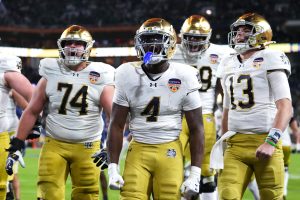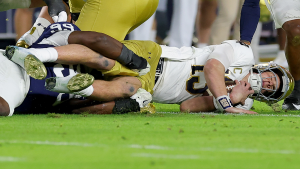College football’s more professionalized era arrives in July, and powerhouses like the four CFP semifinalists could lose their inherent advantages.
COLUMBUS, Ohio — On the wall in Ted Carter’s office is a framed picture of two fighter jets in mid-flight against a blue sky. “I’m in one of those,” he says.
No university president in the country can claim the exploits of Ohio State’s leader.
In 38 years of active military service, Carter, 65, logged more than 6,300 flying hours, flew 125 combat missions, received more than two dozen awards and retired in 2019 as vice admiral, the third-highest rank of the 25 positions in the U.S. Navy.
Given the life-saving missions and life-risking aerial shows of his military career, his next great assignment seems to pale in comparison. But, in certain circles, it may be the most important mission yet: keep Ohio State football relevant in the age of athlete revenue sharing.
“I’ve been thinking about it since the day they hired me,” Carter said from his office during an interview with Yahoo Sports in late November, his 15th month on the job. “The landscape was obviously changing already and now we’re at the doorstep.”
This murky, three-plus year period of college athletics — the “NIL Era,” as it’s known — comes to an end, fittingly, with some of the sport’s most valuable programs battling for the national championship.
On Friday night in Dallas, Ohio State (12-2) meets Texas (13-2) in a collision of, arguably, college football’s two biggest brands with a trip to the national title game on the line. The meeting is a clash between two schools spending more on their football programs and football rosters than, perhaps, any others in America, a pair of blue-blood powers whose investments within the NIL Era have vaulted them to this position.
But can they stay there?
By next season, when college football’s more professionalized era arrives, the historic powerhouses like Ohio State and Texas stand to lose both their decades-long inherent recruiting advantage (their historical brand) and the financial edge they used in this unruly, booster-fueled NIL Era: Donor cash.
The new athlete-revenue sharing world, at least at the highest levels, will be built on transactional recruiting relationships within a system that permits universities to use direct school funds in a more regulated structure featuring a compensation cap and new enforcement arm.
In a world where more parity is expected, where does that leave the big boys?
As it turns out, keeping their advantage is quite simple, experts contend. They use their big brand, sprawling metro areas, massive alumni bases, wealthy donors and rich relationships to exceed college football’s new cap.
“That’s going to be the new frontier: the above-the-cap, supplemental NIL,” says Walker Jones, the head of the Ole Miss collective and a leading member of The Collective Association. “That’s the new battlefield. The question is, can it really be regulated?”
How will schools navigate new system?
While their teams battle on the field this week, executives from these blue-blood powerhouse programs work behind the scenes to assure that they remain atop the sport in the new era.
As part of the NCAA and power conferences’ landmark settlement of antitrust lawsuits, schools can distribute at least $20.5 million to their athletes starting next school year and can expand scholarships to entire rosters as long as they stay within new roster limits.
How to distribute the revenue and how to expand upon scholarships are issues with which administrators are wrangling over.
Many eyes are focused on Columbus. Ohio State operates the richest athletic budget in the country ($275 million) and has one of the biggest student-athlete populations and sports sponsorships of any major conference school (about 1,000 athletes competing in 36 sports).
How will Ohio State do it?
In a sitdown with Yahoo Sports, the school’s president, Carter, and athletic director, Ross Bjork, detail their plan. Ohio State will offer 91 new scholarships (58 to women for Title IX purposes) at an additional cost of $4.5 million (roughly $2 million in Alston payments will be eliminated). The school plans to “stratify” its sports, Carter says, presumably tiering them based on their revenue generation as a way to determine for each the allocation of resources, including the portion of athlete-revenue distribution.
Football, naturally at the top of the tiered system, will have at its disposal “right around” 90 scholarships, Bjork says, only a five-scholarship increase from the current limit. However, the sport will see the most significant distribution of revenue to athletes.
Ohio State plans to distribute their $20.5 million pool in two ways, Bjork says, “proportionally” based on male-female split and a “market-based approach” determined through valid market factors such as a sport’s television viewership, social media impressions, etc.
Though Bjork declined to reveal specific percentages by sport, many of the football-generating giants of FBS plan to disburse the vast majority of their revenue, as much as or more than 90%, to football and men’s basketball — the only two profit-turning sports at many universities. For schools offering the maximum $20.5 million of rev-share pool money, the formula means that football rosters would receive $13-$16 million and men’s basketball rosters $2-$4 million, according to estimates.
For a small number of big-spending schools, these figures are problematic: They are lower than what is already being spent on rosters. For example, in athlete endorsement deals through its collective and brands, Ohio State’s football roster is receiving roughly $20 million in compensation, Bjork told Yahoo Sports in July.
How does that get rectified?
The answer, though not easy, is that athletes land true endorsement and commercial deals from outside the school with third-party brands and companies. Third-party deals do not count against a school’s salary cap. However, in an effort to limit booster involvement, the settlement orders all third-party deals of $600 or more from school-affiliated boosters, or collections of them, to gain approval from a new NIL clearinghouse.
The clearinghouse, operated by Deloitte, is charged with verifying the authenticity of these deals using “fair market value” rates, poised to eliminate phony booster-backed compensation agreements so prevalent in the industry over the previous three years.
While many question the legality of this, power league executives, holding authority over many settlement-related decisions (not the NCAA), contend that the settlement grants them protections to enforce long-standing NCAA rules against booster payments. In fact, they are creating a separate enforcement entity — not the NCAA — to police the cap and levy penalties on those attempting to manipulate it, such as player ineligibility and school fines.
The power conferences have created a “transition team” of athletic directors from the Big Ten, SEC, Big 12 and ACC to explore issues and create a framework related to the cap, clearinghouse and new enforcement arm. Members of the seven-person Deloitte clearinghouse team have met with college administrators over the last several weeks in an effort to educate them on the process — one that remains murky.
At Ohio State, Carter supports “strong penalties” for those violators, but so many questions remain unanswered, he and Bjork say.
“How are rules written? What is the fair market value analysis? What is the database going to look like?” Bjork says. “What does fair market value mean in Columbus, Ohio, compared to, maybe, a small college town? There has to be some kind of differential there.
“We want to be aggressive, use our corporate partners and donors who own companies. They have marketing funds. How do we turn that into agreements with athletes? We think we have the city, alumni base and the population and the sponsors in our existing environment to be aggressive.”
‘There will be some big paydays’
Despite the expanded College Football Playoff paving the way for feisty underdogs, Cinderella stories and low-budget programs — see SMU, Indiana and Boise State — the national semifinalists are all rich blue-blood football powers.
After all, the Buckeyes and Longhorns are No. 1 and No. 2 in athletic budget. In the other semifinal in Miami on Thursday night, Penn State, with the fifth-richest athletic budget, meets Notre Dame, a private school whose budget figures, while undisclosed, are believed to rank in the top 10 in the country.
These are programs that possess enough resources — donor base and community connections — to find creative ways to exceed the cap, experts believe.
In fact, it’s already happening.
Many schools and their affiliated collectives are poised to spend over the cap, some even having already determined over-the-cap budgets. To remain competitive, an over-the-cap budget of $3-$7 million is necessary, some believe.
“If you’re not spending close to $20 million all-in on your football roster, you’re not going to be in the top 20 of schools. That’s where we are trending,” said one school-affiliated collective official who spoke on condition of anonymity. “The trick is, what’s that regulatory body going to look like to justify the $7 million for your football roster?”
That’s the real catch: Can schools devise ways to create booster-backed third-party endorsement agreements or brand deals that can be deemed authentic? Perhaps it depends on how the contracts are written, said Blake Lawrence, the founder of Opendorse, one of the country’s leading NIL platforms that assists more than two dozen collectives.
Unearthing defensible, data-driven deals is key.
“The big question will be the clearinghouse and the role in determining fair market value,” he said. “Is it on a per-activity basis or per-contract basis? If a collective is going to pay an athlete $100,000 over the course of a year, it may raise a red flag, but what if they break it down: 20 appearances at $5,000 a pop?”
Lawrence estimates that five collectives or fewer are paying more than $15 million to their rosters right now. But the numbers are skyrocketing as college sports find itself in a murky transition period.
In preparation for a more regulated system starting in July, schools are spending significant amounts in the recruiting process, front-loading player contracts before those new deals are subject to the clearinghouse. Deals that are struck now or later this spring are not subject to the clearinghouse if compensation is paid to the athlete before the settlement’s scheduled implementation on July 1.
“Schools are getting as much money off the books as they can,” said Russ White, the president of The Collective Association. “There will be some big paydays.”
Right now, the market is inflated by 40%, said Jason Belzer, the co-founder of SANIL (Student Athlete NIL), an organization that manages more than 50 collectives across the nation. The transfer-inducing salary offers led one sitting school president to refer to the current landscape as “bedlam” in a story last month.
In fact, prices are escalating so much that, in the new rev-share era, Belzer anticipates the number of quarterbacks making at least $1 million (currently around 10, he says) to at least double if not triple. He projects the average power conference starting quarterback annual salary to be $700,000 — a 100% jump year-over-year, he says.
“It’s the definition of what happens when you give somebody a blank check,” Belzer said. “It’s like how lottery winners go bankrupt. ‘Here’s a $20 million budget that we’re going to pay! Go spend it!’”
However, Belzer believes that any competently run collective at a major conference program won’t have problems supplementing a football roster for an additional $2-$4 million. Anything beyond that, one collective official says, it gets more difficult.
“We already do $2 million in real deals,” said one SEC collective executive. “We can maybe push it to $4 million.”
Schools are already creating relationships with marketing agencies, or their collectives are transforming into such agencies — all in an effort to build a system of “true” NIL opportunities for athletes that can be considered off the books and over the cap.
Last month, Kansas announced a marketing partnership with Kansas City-based Walz Tetrick Advertising under a corporate NIL program dubbed “FLIGHT.” Earlier this fall, Clemson announced the formation of “Clemson Ventures,” a revenue-generating entity designed to, among other things, “find and manage meaningful and sustainable NIL opportunities for student-athletes,” according to the school’s statement.
Kirby Hocutt, the Texas Tech athletic director, sent a subtle message to his community last month. The school became the first to publicly announce specific distribution amounts under the new revenue-sharing concept. In Year 1, the Red Raiders will allocate $15.1 million to its football roster (74%), $3.6 million to men’s basketball (17.5%), $410,000 to women’s basketball (2%), $390,000 to baseball (1.9%) and about $920,000 to all other sports.
For a southern program situated in a competitive baseball recruiting environment, is $390,000 of revenue share enough for a baseball roster of 34 players? The school plans to offer no new scholarships.
Hocutt’s answer points to a pathway to exceed the cap.
“I would believe that as popular as baseball is in West Texas, as important a program as it is for us, there would be additional — and I would think numerous — true NIL opportunities for those young men in our region if they choose to explore those,” he told The Lubbock Avalanche-Journal.
New structure ripe for more legal action
No single person has been more publicly critical of the NCAA and its power conferences than Tom Mars.
Mars, an Arkansas-based attorney who has for years represented coaches and players against the NCAA, is one of many who does not believe the post-settlement NIL clearinghouse passes the legal smell test. For one, Mars says, it remains unclear how the clearinghouse does not violate the injunction from the Eastern District of Tennessee that permits athletes from negotiating with boosters before they enroll.
In addition to that, Mars uncovered a 2020 study published by Deloitte that, perhaps, calls into question any future judgment on fair market value. The study expressly acknowledges that return on invested talent metrics are not a “silver bullet” and do “not mean that the value proposition of people can simply be reduced to numbers.”
“I don’t think the clearinghouse is going to be able to last very long,” Belzer says. “It’s just the reality. There are a lot of ways around the clearinghouse. Who is to say what fair market value is? They are crazy to think that guys are going to sit around while a third party is going to judge whether these deals are real. Are you kidding me?”
The structure is ripe for legal action — even the two leading plaintiff attorneys who struck the House settlement have publicly expressed doubt in its legality.
“If the NCAA [and power conferences] tries to punish a student or school, if they try to take action against an NIL [collective], I think they’ll probably see that NIL organization in court,” attorney Jeffrey Kessler told Yahoo Sports last fall.
Will the clearinghouse stand in the way not just of booster collective deals but those from booster-owned businesses? In Columbus, for instance, the Schottenstein family is one of the school’s biggest donors. Jay Schottenstein is the executive chairman of Designer Brands and CEO of American Eagle Outfitters.
What about apparel giant Nike, whose founder is none other than Oregon donor Phil Knight? In Tennessee, perhaps the school’s largest athletic donor, Jimmy Haslam, is the chairman of the board of the Pilot Flying J truck stop chain (the school last year struck a sponsorship deal with Pilot for its football stadium).
At Arkansas, the school has long-time donor and sponsorship partnerships with Walmart and Tyson Foods, and at Michigan, the Wolverines have reaped the benefits of their relationship with alum Jolin Ellison, the wife of the second-richest man in the world, Larry Ellison, the co-founder of the software corporation Oracle.
How do you reject any athlete deal struck with these businesses not deemed to be fair market value?
And what about multimedia rights partners like Learfield and Playfly Sports? These companies earn millions from schools by generating revenue through the licensing of the school’s intellectual properties, such as the brand, logo and color scheme. Already dabbling in the NIL world, these businesses are expected to increase their role by pairing a school’s branding with an athlete in NIL activations worth millions — a potential roundabout way for schools to stay clear of the clearinghouse.
Brian Davis, an attorney in California who represents more than 100 football players in the NIL space, plans to file a legal objection to the settlement over the issue.
“I don’t think there is any world where you can require a submission of an NIL contract to some third-party clearinghouse to determine fair market,” said Davis, who heads the Forward Counsel law firm. “I don’t see that ever surviving a challenge in the courts without collective bargaining.”
The clearinghouse is expected to render decisions on individual deals within a matter of days if not hours. If the clearinghouse rejects a deal because it is deemed above fair market value, a school and/or athlete can submit an appeal through a court-overseen arbitration system, according to the settlement agreement.
The parties — NCAA/power conferences vs. the school and/or athlete — will appear before a neutral arbitrator to argue their case. How an arbitrator rules may “depend on what evidence” each side produces during a trial-like set of hearings, Kessler said.
Either way, the power leagues may have another brewing legal fight on their hands. But without proper enforcement, one of the settlement’s primary purposes — to level the playing field by providing regulation and limiting booster involvement — is in doubt.
“It’s going to come down to enforcement,” said Notre Dame athletic director Pete Bevacqua. “You get dinged, so what happens? Are there any repercussions?”
Back at Ohio State, Carter has plenty of questions himself.
“What are going to be the safeguards for NIL? How does that look?” he said. “No one questions that we have the ability to raise money better than most other places, but there’s probably going to have more checks and balances on it, which we support.”
One thing Carter wants to make clear: No taxpayer money will be used to pay Ohio State athletes. The athletic department will remain “self-sustaining,” needing no financial support from the university.
That means finding ways to generate additional revenue, such as new sponsorship deals. The athletic department is in the midst of an “inventory assessment of the football stadium,” Bjork says. The NCAA’s expected and eventual approval of commercial jersey patches looms large, he says. For a valuable brand like Ohio State, jersey patches can fetch eight figures annually.
But the most important aspect is home game attendance. Ohio State, like many major universities, leans financially on its football season ticket sales at 102,780-seat Ohio Stadium, dubbed the Horseshoe (or Shoe). Last year, for instance, Ohio State football generated nearly $65 million in ticket sales and another $57 million in donations, many of which were tied to football season ticket-holders’ seats.
“Got to make sure we fill the Shoe every home game,” Carter says. “That’s our biggest revenue. We must make sure fans are proud of the brand.”
How do you do that?
Nothing secures consistent attendance numbers and season ticket sales more than winning football games.
On Friday night, the Buckeyes get another chance.












